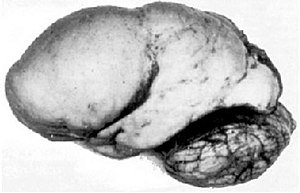Lissencephaly
| Lissencephaly | |
|---|---|
 |
|
| Lissencephalic brain of human. Lacking surface convolutions (Gyrification). | |
| Classification and external resources | |
| Specialty | medical genetics |
| ICD-10 | Q04.3 |
| ICD-9-CM | 742.2 |
| OMIM | 607432 601545 247200 300121 236670 253800 253280 257320 611603 300215 |
| DiseasesDB | 29492 |
| MeSH | D054082 |
| GeneReviews | |
| Orphanet | 48471 |
Lissencephaly is a set of rare brain disorders where the whole or parts of the surface of the brain appear smooth. The word lissencephaly is derived from the Greek λισσός lissos meaning "smooth" and encephalos meaning "brain". It is caused by defective neuronal migration during the 12th to 24th weeks of gestation resulting in a lack of development of brain folds (gyri) and grooves (sulci). It is a form of cephalic disorder. Terms such as agyria (no gyri) and pachygyria (broad gyri) are used to describe the appearance of the surface of the brain. Children with lissencephaly generally have significant developmental delays, but these vary greatly from child to child depending on the degree of brain malformation and seizure control. Life expectancy can be shortened, generally due to respiratory problems.
Affected children display severe psychomotor retardation, failure to thrive, seizures, and muscle spasticity or hypotonia. Other symptoms of the disorder may include unusual facial appearance, difficulty swallowing, and anomalies of the hands, fingers, or toes.
The diagnosis of lissencephaly is usually made at birth or soon after by ultrasound,computed tomography (CT), or magnetic resonance imaging (MRI). However, these results should be interpreted cautiously since even experienced radiologists can misdiagnose polymicrogyria, a different developmental malformation of the brain, as lissencephaly.
...
Wikipedia
